martes, 9 de agosto de 2011
SURF TOURNAMENT AT PLAYA MADERAS (SAN JUAN DEL SUR) AUGUST 2011
Surf Tournament will be held at Playa Maderas (San Juan Del Sur) on the 26th, 27th and 28th of August 2011. Playa Maderas was chosen for this event because of the features, climate and the consistency of the waves.“The tournament will be broadcast live via the internet and will reach the international media as well as the ESPN television network and the Latin American magazine ‘Olas Permanentes’, Vos TV is the event’s official TV channel and Radio La Marca (90.9 en Managua) is the radio channel promoting the event nationally.” 88 participants representing 15 countries are confirmed to date. The Surf Tournament at Playa Maderas is a Category 6 Star event and the total prize money will be US $20,000. TAKE ADVANTAGE OF OUR LOW RATES TO STAY IN BAHIA DEL SOL VILLAS & CONDOMINIUMS DURING THESE DATES OF THIS SURF TOURNAMENT.
TORNEO DE SURF PLAYA MADERAS (SAN JUAN DEL SUR) AGOSTO 2011
Un Torneo De Surf se celebrará en Playa Maderas (San Juan Del Sur) en el. 26, 27 y 28 de agosto 2011 Playa Maderas fue elegida para este evento debido a las características, el clima y la consistencia de las olas. "El torneo será transmitido en vivo a través de Internet y llegará a los medios de comunicación internacionales, así como la ESPN la red de televisión y La Revista Latinoamericana ' OlasPermanentes ", Vos TV es el canal de televisión oficial del evento y Radio La Marca (90,9 en Managua) es el canal de radio que esta promocionando el evento a nivel nacional. "88 participantes representando a 15 países están confirmados hasta la fecha. El torneo de Surf en Playa Maderas es un evento de categoría 6 estrellas y el dinero del premio total será de US$ 20.000. APROVECHE NUESTRAS TARIFAS FAVORABLES PARA ALOJARSE DURANTE LAS FECHAS DE ESTE EVENTO.
domingo, 7 de agosto de 2011
PACKAGES (Spring Break & Sun, Sand & Fun)
SPRING BREAK PACKAGE
Round trip transportation (MNG-SJDS-MNG)
• Lodging 5 nights
• 6 pax
• Sailing Trip
• Quads Tour
• Canopy Tour
• Surf classes with NSR
• 1 Bottle of Grand Reserve Rum, 1 Bottle of Extra Lite Rum, 6 Victorias and 6 Tonas
• 15% discount in Arribas Bar (needed to show key-holder of your villa)
Price
High Season
(Feb 24th to April 17th, Nov 1st to Dec 14th 2011)
U$ 2,325.43 (U$387.57 per person).
Holiday Season
(April 19th to April 24th, Sep 13th to Sep 18th, Dec 15th 2011 to Jan 2nd 2012)
U$ 3,151.52 (U$525.25 per person).
Green Season
(April 18th to October 31st 2011)
U$ 2,064.57 (U$344.09 per person)
SUN, SAND & FUN
Round trip transportation (MNG-SJDS-MNG)
• Lodging 4 nights
• 6 pax
• Half day Fishing
• Surf Class with NSR
• Kayaks tours
• Horseback riding
Price
High Season
(Feb 24th to April 17th, Nov 1st to Dec 14th 2011)
U$ 1728.35 (U$288.06 per person).
Holiday Season
(April 19th to April 24th, Sep 13th to Sep 18th, Dec 15th 2011 to Jan 2nd 2012)
U$2389.22 (U$398.20 per person).
Green Season
(April 18th to October 31st 2011)
U$ 1519.65 (U$253.28 per person)
Round trip transportation (MNG-SJDS-MNG)
• Lodging 5 nights
• 6 pax
• Sailing Trip
• Quads Tour
• Canopy Tour
• Surf classes with NSR
• 1 Bottle of Grand Reserve Rum, 1 Bottle of Extra Lite Rum, 6 Victorias and 6 Tonas
• 15% discount in Arribas Bar (needed to show key-holder of your villa)
Price
High Season
(Feb 24th to April 17th, Nov 1st to Dec 14th 2011)
U$ 2,325.43 (U$387.57 per person).
Holiday Season
(April 19th to April 24th, Sep 13th to Sep 18th, Dec 15th 2011 to Jan 2nd 2012)
U$ 3,151.52 (U$525.25 per person).
Green Season
(April 18th to October 31st 2011)
U$ 2,064.57 (U$344.09 per person)
SUN, SAND & FUN
Round trip transportation (MNG-SJDS-MNG)
• Lodging 4 nights
• 6 pax
• Half day Fishing
• Surf Class with NSR
• Kayaks tours
• Horseback riding
Price
High Season
(Feb 24th to April 17th, Nov 1st to Dec 14th 2011)
U$ 1728.35 (U$288.06 per person).
Holiday Season
(April 19th to April 24th, Sep 13th to Sep 18th, Dec 15th 2011 to Jan 2nd 2012)
U$2389.22 (U$398.20 per person).
Green Season
(April 18th to October 31st 2011)
U$ 1519.65 (U$253.28 per person)
sábado, 6 de agosto de 2011
NICARAGUAN FOOD
Traditional Food
The Nicaraguan culinary art dates back to the pre-Colombian times, as you can tell by the names of the most known plates. Back then, during colonial times, the peculiar, creative, and varied Creole menu was the result of the union of these two races. In this type of food, ranging from soups and meats to a diversity of sweets, interesting ingredients are used.
Sons of Corn
Since its origin, the fundamental basis of Nicaraguan gastronomy has been corn. Thus, its wide usage and derivatives constitutes the culinary inheritance left by indigenous tribes that lived in the area. This fact explains the similarities between the typical Nicaraguan food and those of other countries in the Central American region and Mexico. We all were sons of corn.
Corn, as ingredient, has many different uses: lots of drinks are made from corn, such as Chicha and Pinol; as well main dishes such as Nacatamal, Indio Viejo, and Sopa de Albondiga; and snacks and sweets such as Atolillo andPerrereque.
A World of Ingredients
There are also other ingredients widely used in the Nicaraguan kitchen, mostly local, tropical products. Nevertheless, Nicaraguan culinary creativity is meticulous and open, which enables the utilization of ingredients used all around the world such as tomato, onion, garlic, flour, rice, orange, mustard and mayonnaise, milk and cheese, vanilla and cinnamon, and more.
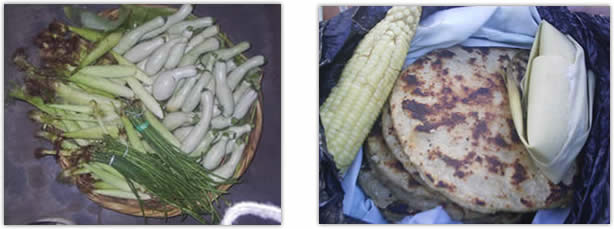
Pipian, corn, and red beens (to the left), and corn and tortillas (photo to the right).
But what makes Nicaraguan food unique are those local ingredients discussed before. Below follows a selection of those ingredients, some of which are probably unknown to readers from non-tropical countries:
Fruits such as jocote, mango, papaya, tamarind, bananas (used a lot in Nicaragua), pipian, and avocado; roots such as yucca (also of a lot of use in typical national food), and quequisque; herbs such as culantro (also called cilantro), oregano, and achiote.
Another interesting aspect of the Nicaragua cuisine is the meat that is being eaten. Some foreigners, especially Europeans, might find the following hard to believe. From the cow, for example, some dishes are prepares using the tale, the udder, the stomach, or the brain; from the bull, the testicles; from the pork, the skin (which is used to make the famous chicharron), hoofs, and the blood (to make morongas).
In addition – and this is something not appreciated by ecologists – Nicaraguans eat turtle eggs, lizards, armadillos, and boas (boas are eaten mainly in the Central and Northern region of Nicaragua). Do note that all these species are currently threatened with extinction.
The Most Famous Plates
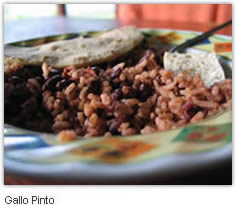 There are a lot traditional Nicaraguan dishes. Each region, according to geographical and cultural characteristics, produced various dishes, drinks, and sweets. Throughout the years, those dishes became known in the whole country. Some cities still are still known as the one that originated the idea of some food and they still specialize in creating this food, but most of the dishes passed to be national dishes. Below you will find an overview of the most famous Nicaraguan dishes.
There are a lot traditional Nicaraguan dishes. Each region, according to geographical and cultural characteristics, produced various dishes, drinks, and sweets. Throughout the years, those dishes became known in the whole country. Some cities still are still known as the one that originated the idea of some food and they still specialize in creating this food, but most of the dishes passed to be national dishes. Below you will find an overview of the most famous Nicaraguan dishes.Gallo Pinto: most people in Nicaragua eat this almost daily and it is considered a national symbol. It is composed of a mixture of fried rice with onion and sweet pepper, red beans boiled with garlic. They are mixed and fried all together.
Nacatamal: a dough which is prepared with ground corn and butter. This is then filled up with small pieces of pork or chicken, rice, potatoes, tomatoes, onion, sweet pepper (all in slices). This mixture is packed in leaves of plantain trees (not edible), tightened with a small thread, that makes it look like a tiny pillow. It is then cooked inside the leaves and boiled during five hours.
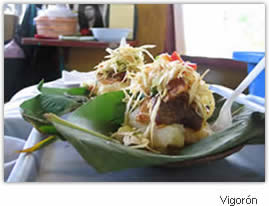 Vigorón: originally from Granada, where it is deliciously prepared. A plate is covered with a part of a plantain tree leaf, on top of which yucca, chicharrón and a salad made out of cabbage and tomato is placed.
Vigorón: originally from Granada, where it is deliciously prepared. A plate is covered with a part of a plantain tree leaf, on top of which yucca, chicharrón and a salad made out of cabbage and tomato is placed.Indio Viejo: meat is prepared with onions, garlic, sweet pepper and tomato. In addition, some tortillas are put into water and this has to be ground until they form dough. The meat is shredded and then fried with vegetables, the dough, and orange juice. Finally, you add broth.
Quesillo: originally from La Paz Centro and Nagarote, in the department of León. The quesillo is easy to prepare. A piece of cheese (which is named quesillo) is placed inside a tortilla. This is then wrapped up in a plastic bag. Onions and vinegar are added, and the finishing touch is to put fresh cream and a bit of salt on top.
Sopa de Mondongo: this soup is the specialty of Masatepe, in the department of Masaya. The mondongo is washed with a lot of bicarbonate, orange, and lemon. Next step is to cut it in small pieces and cook it with onion, sweet pepper, and garlic. When the mondongo is soft enough, grind rice is added, as well as vegetables in pieces, such as quequisque, chayote, sweet pepper, onion, corn. This should be kept cooking until the soup is ready. You can eat this with avocado and cheese.
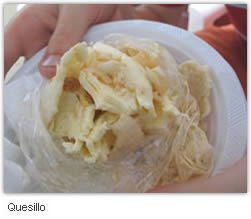 Arroz-con-Piña Drink: for this drink you boil a “four leaf clover”, a pineapple and rice, until the rice is soft enough. The drink is then being cooled and blended, adding water. Afterwards, remove the solid part, leaving only the liquid part. Add a little bit of vanilla, strawberry and sugar, as you desire.
Arroz-con-Piña Drink: for this drink you boil a “four leaf clover”, a pineapple and rice, until the rice is soft enough. The drink is then being cooled and blended, adding water. Afterwards, remove the solid part, leaving only the liquid part. Add a little bit of vanilla, strawberry and sugar, as you desire.Chicha-de Maíz: this drink needs a process of a couple of days. The corn is left in water for an entire night so it gets soft. Grind it the next day and then place it in water, adding red colorant. The next step is to cook it. When it cools, you add a type of candy called “dulce” and more water. The next day, you add more water and sugar.
Tres Leches: this is a dessert prepared with milk, condensed milk and cream. This is where the name comes from (three milks). You prepare a cake with flour and eggs, and then you add the mixture of these three milks. Finally, place a crown of meringue.
Cajeta de Coco: to do this use coconut, the coconut’s water, yucca and a candy called “dulce”. The coconut and the yucca are cut in thin strings. The water and the “dulce” are cooked until they make up a kind of honey, to which you add the strings of coconuts and yucca. You then mix those and that's it!
Rosquillas: These appetizers are the specialty of Somoto, in the department of Madriz. Corn dough is combined with cheese, egg, butter and lard. You give them a circular form and you bake them until they toast.
Caribbean Flavors
In Nicaragua, culture changes from one coast to the other, and the Caribbean Coast also has its part in traditional dishes. Here other important ingredients such as coconut are used.
Rondon: traditionally from Bluefields. Rondon is prepared with turtle meat, fish, and red meat or pork. Sometimes you combine two of these meats. When preparing, cook the meat with pepper, hot pepper, a herb named nargan, onion, sweet pepper, banana, yucca and quequisque.
Gaubul: this is a typical drink in the Nicaraguan Caribbean, almost unknown in the Pacific and center of the country. To create this drink, make a mixture of green banana (cooked beforehand and mashed in water), milk and coconut water, and a little bit of sugar.
Rice and Beans: this is the same as Gallo Pinto and it is prepared in the same way, using rice and red beans. The only difference is that it is fried with oil made out of coconut, which gives the plate a different and special flavor.
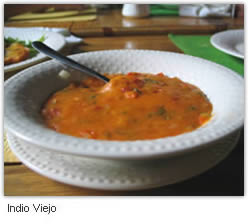 Go ahead and try them!
Go ahead and try them!To some foreigners, Nicaraguan food might seem little inviting, strange, or even unedible. There is an urban tale related to this about a North American who was eating a Nacatamal. When he finished, someone asked if he liked it, and he answered: “It was very good, but the only thing I didn’t like was that the lettuce was too bitter”; obviously, he thought that the lettuce was the plantain tree leaf, with which you wrap the Nacatamal, and which you do not eat!
Some believe that Nicaraguan food is very oily and that juices are too sweet. This is indeed true sometimes. Nevertheless, do not let it scare you off; go ahead and taste the delicious Nicaraguan traditional dishes!
Nicaraguan Currency (Nicaraguan Money)
Nicaragua currency






The Nicaragua's currency is the Cordoba, it borned in 1912 in honour of Francisco Hernandez de Cordoba one of the spanish captains that conquested Nicaragua. In the common language it is called peso.
You can find coin of ½, 1 and 5 Cordoba and bill of 10, 20, 50 and 100 Cordoba. You can also find banconotes for hundredth part of Cordoba, but you can't buy a lot of things with these banconotes. For the most part in Nicaragua you can indifferently pay by Cordoba or by dollars. You can also use credit card like VISA, America Express e Master card.
In the city of Managua you can find automatic cashes besides supermarkets and petrol pumps however is better going to the banks. The Bank of Central America offers good and cheaply services as regards automatic cashes. The change cordoba/dolares is fixed by Banco Central; now is 18.2 Cordobas for 1 dollar.
Till now there is'nt an official exchange for european money so it is better travelling with american dollars. If you travel with Central America's Country currency usually you do not have problems to change your currency at the Nicaragua's border or at the airport's offices
When you are in Nicaragua you can change currency at the bank or, if you have rush, you can find in the street people (called "coyotes"), witch change dollar in Nicaragua's currency, the rate is similar at bank's rate.
All banks offer the change operations with a rate equal at the official rate, the only problem is the long queue witch you can find at the cash desk. The best time do this operation is after lunch.




Difference Between Villa/Vacation Rentals and Timeshares
Consumers unfamiliar with the concept of a vacation rental may confuse it with the seemingly similar, but distinctly different, timeshare. A timeshare can still be rented as a vacation rental should an owner decide to put his owned week(s) on a vacation rental program. Many timeshare resorts offer quarter-ownership which offers the owner 13-weeks of ownership and, therefore, more weeks to offer for rental.
A timeshare is a piece of real estate—often a fully furnished condominium—that is jointly shared by multiple owners. While different types of timeshare ownerships exist, in general, each owner bears a portion of the responsibility, along with the right to a segment of time in which he or she is granted sole use of the property. Timeshare resorts allow financially qualified guests to rent and tour their unowned properties and then make those properties available to the guest for purchase. Timeshare owners can also choose to bank their week with and exchange company such as RCI, or rent the unit.
Pros and cons of vacation rentals
Vacation and villa rentals are generally appealing for many reasons, some of the foremost being cost savings, more space, and no tips or service charges that are associated with hotel rooms. Villa and vacation rentals have kitchens for cooking, living rooms for gathering together and offer the appeal of living in a real neighborhood and soaking up the rhythm of the locals. Rental properties are usually privately owned vacation properties with the facilities that owners need for their own enjoyment such as sports and beach equipment, games, DVD libraries and books, and in warmer locations a swimming pool. Hotels often enjoy the advantages of brand recognition, familiar reservation processes, and on-site staff for problem resolution. For a guest, booking a vacation rental may mean stepping out of that comfort zone in order to garner some of the advantages they offer. Perceived cons of vacation rentals can include being unfamiliar with the property, lack of on-site staff, and concerns about quality or cleanliness—however, these are most often mitigated by dealing directly with the villa or vacation rental owner, who can address such concerns and provide references.
The benefits generally outweigh the potential negatives, with many vacation rentals offering more space (multiple bedrooms and bathrooms, separate living areas), more amenities (fully equipped kitchens, fireplaces, private hot tubs), convenient locations (on the beach, ski-in/ski-out, city centers in real neighborhoods) and greater privacy than a hotel, including the fact that many villa/vacation rentals give travelers the option of inhabiting real neighborhoods in their destination and living like the locals. As of 2006, vacation rental management has become a $10 billion industry and continues to become more popular.
COME AND ENJOY A STAY IN ONE OF OUR VILLAS. WE PROVIDE DAILY CLEANING SERVICE (MAID SERVICE), MINI BAR SERVICE IN THE VILLAS, EXCURSIONS AND TOURS INFORMATION AND RESERVATION, AND SO MUCH MORE!
You can contact us at reservations@bahiadelsolnica.com, info@bahiadelsolnica.com, tel, 505-2682828, cel. 505-87392040, cel. 505-89099300.
Check out our website at http://www.bahiadelsolnica.com/
viernes, 5 de agosto de 2011
Latitud, Longitud, Altitud, Rios y Playas de San Juan Del Sur
San Juan del Sur se encuentra en la latitud 11 º y 15 ' norte, 85 º y 53 'de longitud oeste, su altitud es de 3,58 metros sobre el nivel del mar.
En 1996 su población llegó a 13.786 habitantes para una densidad de 19,5
habitantes por km2, su temperatura promedio es de 27 º C y hace unos 1660mm de precipitación por año, se ha una superficie total de 598 km2 y sus distritos son: Las Brisas, Carrizal, La Cuesta, Ostional, Plan Grande,
Pueblo Nuevo y Tortuga.
Los ríos más importantes son: San Juan, Escameca, Escamequita, La Flor, Ostional, El Naranjo y Marsella.
La ciudad está a 140 kilómetros de la capital, Managua y tan sólo 43 kilómetros de la frontera de Peñas Blancas.
Es común escuchar historias de las luchas entre los vientos del norte y del sur, llamado Papagayos o Noreste, que están presentes desde diciembre hasta febrero, los fuertes vientos del oeste y el sur látigo de mayo a
De octubre.
San Juan del Sur tiene más de 14 vírgenes y hermosas playas, verdadero paraíso donde los seres humanos no han ejercido su poder. Algunas de las playas destacan son: San Juan del Sur una bahía horseshow, Maderas, Marsella, Majagual, Popoyo, Eddy, Yanki, La Flor, El Coco, Ostional, Ocotal, Playa Blanca, Playa Rosada, entre otros.
Sus elementos económicos principales son la agricultura, la pesca y el turismo, aunque también en los alrededores de San Juan son de cal minas, canteras de piedra, el carbón y el franco suelos calcáreos que son buenas para la producción de cerámica
habitantes por km2, su temperatura promedio es de 27 º C y hace unos 1660mm de precipitación por año, se ha una superficie total de 598 km2 y sus distritos son: Las Brisas, Carrizal, La Cuesta, Ostional, Plan Grande,
Pueblo Nuevo y Tortuga.
Los ríos más importantes son: San Juan, Escameca, Escamequita, La Flor, Ostional, El Naranjo y Marsella.
La ciudad está a 140 kilómetros de la capital, Managua y tan sólo 43 kilómetros de la frontera de Peñas Blancas.
Es común escuchar historias de las luchas entre los vientos del norte y del sur, llamado Papagayos o Noreste, que están presentes desde diciembre hasta febrero, los fuertes vientos del oeste y el sur látigo de mayo a
De octubre.
San Juan del Sur tiene más de 14 vírgenes y hermosas playas, verdadero paraíso donde los seres humanos no han ejercido su poder. Algunas de las playas destacan son: San Juan del Sur una bahía horseshow, Maderas, Marsella, Majagual, Popoyo, Eddy, Yanki, La Flor, El Coco, Ostional, Ocotal, Playa Blanca, Playa Rosada, entre otros.
Sus elementos económicos principales son la agricultura, la pesca y el turismo, aunque también en los alrededores de San Juan son de cal minas, canteras de piedra, el carbón y el franco suelos calcáreos que son buenas para la producción de cerámica
LOCATION & HISTORY OF SAN JUAN DEL SUR
Views of the Bay of San Juan Del Sur.
Another View of the Bay Of San Juan Del Sur.
View Of The Bat Of San Juan Del Sur.
Another View of the Bay Of San Juan Del Sur.
View Of The Bat Of San Juan Del Sur.
martes, 2 de agosto de 2011
SURF'S UP
Surf’s up!
Nicaragua is quickly becoming known as a surfer’s paradise – here in Central America and throughout the world. With steady winds year-round and its remote beaches, Nicaragua is the new up and coming surf destination. Whether you are a beginner or a shredder, we know the guides who know the waves.
Rental gear is also available.
You can reserve your surf lessons or surf trips through our receptionists in our office at the Hotel.
WATER ACTIVITIES
Sailing Adventures
Explore the local coastline of San Juan del Sur. We can help you to arrange two types of trips; a full day sail (including beachcombing, snacks and beverages and a gourmet barbecue lunch), and a breathtaking sunset cruise. We don’t mind saying that both are spectacular; you’ll be treated to delicious snacks and drinks for the duration of your sail.
Sea Kayaks
 Enjoy a peaceful morning or afternoon ride cruising along the beautiful bay of San Juan del Sur in one Kayak. Life vests, paddles, helmets and operation instructions are included. Hourly, daily and weekly rentals are available; adult and child size kayaks are available, too.
Enjoy a peaceful morning or afternoon ride cruising along the beautiful bay of San Juan del Sur in one Kayak. Life vests, paddles, helmets and operation instructions are included. Hourly, daily and weekly rentals are available; adult and child size kayaks are available, too.Panga Tours
“Panga” is the local term for an outboard motor fishing boat. These types of boats are available for hire to explore the phenomenal coastline and pristine beaches, or for a day of fishing.
MARITIME ACTIVITIES NEARBY


Sailing Adventures
Explore the local coastline of San Juan del Sur. We can help you to arrange two types of trips; a full day sail (including beachcombing, snacks and beverages and a gourmet barbecue lunch), and a breathtaking sunset cruise. We don’t mind saying that both are spectacular; you’ll be treated to delicious snacks and drinks for the duration of your sail.
Sea Kayaks
Enjoy a peaceful morning or afternoon ride cruising along the beautiful bay of San Juan del Sur in one Kayak. Life vests, paddles, helmets and operation instructions are included. Hourly, daily and weekly rentals are available; adult and child size kayaks are available, too.
Panga Tours
“Panga” is the local term for an outboard motor fishing boat. These types of boats are available for hire to explore the phenomenal coastline and pristine beaches, or for a day of fishing.
Suscribirse a:
Entradas (Atom)











